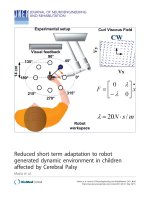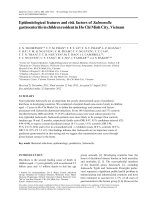Cerebral Angiography in children
Bạn đang xem bản rút gọn của tài liệu. Xem và tải ngay bản đầy đủ của tài liệu tại đây (1.69 MB, 21 trang )
Cerebral Angiography
in Children
Dr. Nguyen Ngoc Pi Doanh
Dr. Dang Ngoc Dung
• Angiography is a
minimally invasive
medical test that
uses x-rays and an
iodine-containing
contrast material to
produce pictures of
blood vessels in the
brain.
• Gold standard for
imaging cerebral
vasculature
Neurointervention
NeuroAngiography
Indications
•
•
•
•
Diagnosis of primary neurovascular disease
Planning for neurointerventional procedure
Intra-operative assistance
Follow-up Imaging after treatment
Procedure
Procedure
Complications
Blood clot
Air
vasospasm
Complications
Neurological
Complications
-Cerebral ischemia
-Transient cortical blindness
-Amnesia
Nonneurological
Complications
- Hematoma
- Allergic reaction
- Femoral artery
pseudoaneurysm
- Nephropathy
- Thromboembolisim of
the lower extremitries
- Pulmonary embolism
Complications
• 19.826 pts
• 1981-2003
• Neurologic complications: 522 (2.63%)
– stroke with permanent disability : 27 (0.14%)
– Death : 12 (0.06%)
• Access-site hematoma : 4.2%
- 2000, Denmark
- 483 cerebral angiography/ 454 pts
• 2001-2006, 2.924 diagnostic Cerebral
Angiography, - U.K
• Clinical complications: 23 (0.79%)
– Puncture-site hematoma: 12 (0.41%)
– Transient neurological events: 10 (0.34%)
– Nonfatal reaction with contrast agent : 1
– Permanent neurological Complications : 0
/>
Radiographic: vasospasm , intraarterial dissection
Complications
In our Department
• > 100 Diagnostic Cerebral
Angiography/ year
• 2 complications
– 1 Broken catheter Reuse
– 1 Permanent neurological
Deficit.
Conclusion
• Gold Standard
• Invasive procedure- low complications
0-2% (neurological deficit)
Indication
• Anatomy, skill, training
Thanks for your attention









